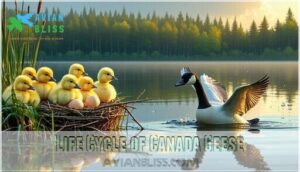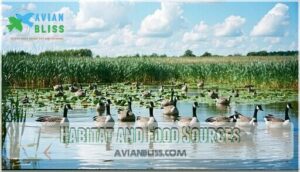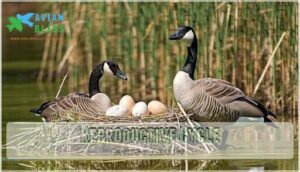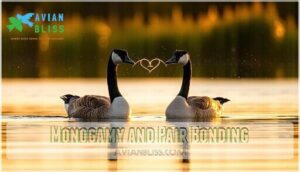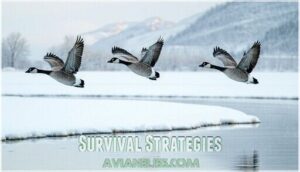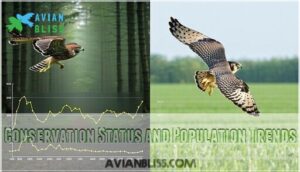This site is supported by our readers. We may earn a commission, at no cost to you, if you purchase through links.
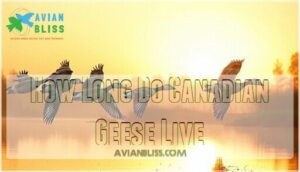 Ever wondered how long these honking nomads of the sky actually stick around? You’ll be surprised!
Ever wondered how long these honking nomads of the sky actually stick around? You’ll be surprised!
Canadian geese typically live 10 to 24 years in the wild, with some hardy individuals pushing the envelope to 33 years.
Their survival depends on factors like habitat, predation, and environmental conditions. While urban geese might enjoy longer lifespans due to fewer natural threats, wild populations face more challenges.
Factors like food availability, weather patterns, and human interactions play key roles in determining how long these remarkable birds will waddle and soar.
Want to know what secret survival strategies help them beat the odds?
Table Of Contents
- Key Takeaways
- Canada Goose Lifespan Overview
- How Long Do Canadian Geese Live
- Life Cycle of Canada Geese
- Common Predators and Threats
- Habitat and Food Sources
- Reproductive Cycle
- Monogamy and Pair Bonding
- Survival Strategies
- Conservation Status and Population Trends
- Longest Recorded Lifespan
- Frequently Asked Questions (FAQs)
- How old is the oldest Canadian geese?
- How long do tame geese live?
- What is the life cycle of a Canadian geese?
- How do Canadian geese survive a loss of a mate?
- Do Canadian geese mate for life?
- What is the oldest Canadian goose on record?
- Do wild geese live for 100 years?
- What is the natural predator of Canadian geese?
- Where do Canadian geese sleep at night?
- What do Canada geese eat?
- Conclusion
Key Takeaways
- You’ll find Canadian geese typically live 10 to 24 years in the wild, with some hardy individuals pushing their lifespan to an impressive 33 years through remarkable survival strategies.
- They adapt to diverse environments, from urban parks to wetlands, using sophisticated survival tactics like lifelong pair bonding, strategic migration, and collective defense mechanisms.
- A goose’s lifespan depends on critical factors like habitat quality, predator interactions, food availability, and their ability to navigate challenges from both natural and human-modified landscapes.
- You’ll see captive geese can live even longer, with some reaching up to 42-49 years when provided with specialized diets, veterinary care, and protection from the typical threats they’d face in the wild.
Canada Goose Lifespan Overview
Have you ever wondered how long those honking giants of the sky actually survive in the wild?
Canadian geese, with their impressive resilience, typically live between 10 to 24 years.
They face numerous challenges from predators, harsh weather, and environmental changes that test their remarkable survival skills.
Factors Affecting Lifespan
Surprisingly, the lifespan of Canada geese is a complex journey fraught with challenges. These resilient birds navigate a gauntlet of survival obstacles that directly impact their longevity.
- Predator Impact: Eagles, foxes, and coyotes constantly threaten their existence
- Habitat Quality: Urban sprawl and climate change shrink their living spaces
- Migration Hazards: Exhausting journeys test their physical endurance
Human activities like vehicle collisions and pollution add another layer of complexity to their survival.
Food availability, disease risks, and environmental conditions play important roles in determining how long these remarkable birds will roam the skies. Their lifespan is a delicate balance between adaptation and resilience.
Average Lifespan in The Wild
In the wild, Canada geese navigate a challenging landscape, with lifespans typically ranging from 10 to 24 years.
These resilient birds face numerous survival hurdles that shape their life expectancy.
| Factor | Impact on Lifespan |
|---|---|
| Predation | Significant Reduction |
| Food Availability | Critical Survival Determinant |
| Habitat Quality | Directly Influences Longevity |
| Climate Conditions | Extreme Challenges |
| Human Interference | Potential Threat |
Their survival is a confirmation to nature’s delicate balance.
Average Lifespan in Captivity
After braving the unpredictable wilderness, Canada geese find sanctuary in captivity, dramatically extending their life expectancy.
Their goose lifespan can reach an impressive 42 years with:
- Specialized captive diets
- Regular veterinary care
- Protection from predators
- Controlled breeding impacts
- Optimized genetic diversity
Human interaction transforms these resilient birds, offering them a chance to thrive far beyond their wild counterparts.
How Long Do Canadian Geese Live

Ever wondered about a Canada goose’s remarkable journey through life? These resilient birds typically live 10 to 24 years in the wild, with some beating the odds and reaching 30. Their lifespan is a demonstration to survival’s intricate dance.
- Environmental challenges shape their survival
- Captivity extends life dramatically
- Genetic resilience plays a key role
- Diet and habitat make all the difference
Captive geese can live up to 50 years, sheltered from predators and harsh conditions.
Domestic geese benefit from regular veterinary care, which can greatly extend their lifespan.
It’s a striking contrast that reveals nature’s delicate balance between wild survival and protected existence.
Life Cycle of Canada Geese
If you’re curious about the fascinating journey of Canada geese, you’ll want to understand their remarkable life cycle.
From the moment they hatch as vulnerable goslings to their impressive migrations, these birds navigate a complex path of survival, growth, and reproduction that’ll leave you in awe of their resilience.
Breeding Season
You’ll witness the remarkable breeding season of Canada geese unfold as spring emerges.
Females carefully scout nesting sites while males vigilantly protect their territories.
Their monogamous pairs collaborate to construct intricate nests using soft grasses and down, typically preparing a clutch size of 2-10 eggs.
Parental care is paramount, with both partners sharing responsibilities during breeding.
Their synchronized efforts reflect a deep commitment to breeding success, highlighting their complex social dynamics and strategic seasonal timing that guarantees the survival of their future goslings.
Incubation Period
After the whirlwind of courtship, female Canadian geese begin their most patient performance: incubation.
This 28-30 day marathon demands incredible dedication from both parents, transforming a simple nest into a life-support system for developing eggs.
Here’s what happens during this extraordinary period:
- Mom maintains a precise body temperature around 98.6°F, creating a perfect microclimate for egg development.
- Dad stands sentinel, scanning the landscape for potential predators that might threaten their future family.
- The nest becomes a fortress of carefully arranged downy feathers and surrounding vegetation, offering camouflage and protection.
Temperature regulation isn’t just a task—it’s a survival strategy that can mean the difference between hatching success and total nest failure.
Every degree matters in this delicate reproductive dance.
Gosling Development
Watch tiny goslings transform from helpless chicks to independent adventurers in mere weeks!
After hatching, they quickly develop downy feathers and learn key survival skills.
Swimming comes naturally, while foraging techniques are carefully taught by watchful parents.
Their rapid growth prepares them for the challenging world ahead, with each week bringing remarkable developmental milestones that guarantee their survival.
Fledgling Stage
As goslings grow feathers and strength, they enter the fledgling stage—a make-or-break period for survival.
Young geese master critical skills through intense learning and parental guidance:
- Master flight techniques
- Navigate complex social structures
- Develop predator avoidance strategies
Their post-fledging independence hinges on quick learning, with parental care steering them toward survival in challenging wilderness environments.
Common Predators and Threats
You’ll be surprised to learn that Canadian geese face a gauntlet of threats in the wild, from cunning predators to human-made hazards.
Their survival depends on traversing a complex ecosystem where foxes, eagles, and even vehicle collisions can dramatically impact their lifespan. Their survival depends on traversing a complex ecosystem where foxes, eagles, and even vehicle collisions can dramatically impact their lifespan.
Natural Predators
Nature’s survival game hits hard for Canada geese, with predators lurking at every turn.
Foxes and coyotes prowl grasslands, while raptors patrol skies searching for vulnerable prey. These natural predators dramatically impact goose lifespan, turning each day into a strategic dance of survival.
Snapping turtles wait in water, and bobcats stalk through wilderness edges, creating a gauntlet of danger.
Despite constant threats, Canada geese have evolved impressive evasion tactics, forming protective family groups and maintaining sharp vigilance.
Their resilience transforms potential prey into cunning survivors against nature’s unforgiving predator landscape.
Avian Flu
Every single Canada goose faces a lethal threat from avian flu, a virus dramatically reducing goose life expectancy.
Transmission pathways include direct contact with infected birds’ saliva and feces, causing severe economic impacts.
With mortality rates climbing, prevention strategies become paramount for protecting these waterfowl.
Understanding avian flu’s spread can help safeguard goose populations and future outbreaks.
The recent discovery of dead geese in Otisco Lake and Seneca River highlights this threat.
Collisions With Vehicles and Power Lines
Avian flu’s threat leads to another human-induced challenge for Canadian geese.
Road Collision Risks and Powerline Electrocution claim hundreds of lives annually.
Here’s how you can help:
- Slow down near water habitats
- Install wildlife warning signs
- Support urban planning for safe goose corridors
Protecting these resilient birds means understanding their urban survival strategies and minimizing human-related hazards.
Habitat and Food Sources
You’ll be amazed at how Canadian geese adapt to diverse environments, from wetlands to city parks, finding food wherever they roam.
Their diet shifts dramatically with seasonal changes, showcasing remarkable versatility in feeding strategies that help them survive and thrive in challenging landscapes.
Preferred Habitats
Countless Canada geese call diverse landscapes home, from wetland marshes to sprawling urban parks.
These adaptable birds seek out open spaces near reliable water sources, carefully selecting habitats that guarantee their survival and longevity.
Grasslands, city parks, and agricultural fields provide ideal nesting locations and food availability.
To support these birds, consider planting beneficial waterfowl vegetation.
By strategically choosing their habitat, Canada geese maximize their chances of thriving in both wild and human-modified environments.
Seasonal Changes in Diet
Ever wondered how Canada geese survive seasonal menu changes?
Their diet transforms dramatically throughout the year:
- Spring Greens: Tender grasses and emerging shoots
- Summer Berries: Wild fruits and aquatic vegetation
- Fall Grains: Harvested crop remnants and seeds
- Winter Food: Stored energy from previous seasons
These diet adaptations make certain Canada geese thrive by matching food availability with seasonal habitat challenges.
Supplementing their diet with proper goose nutrition can also be beneficial.
Adaptation to Urban Environments
Geese have mastered urban survival, turning city parks into prime real estate.
They’ve learned to exploit human-modified landscapes, transforming lawns, ponds, and green spaces into thriving habitats.
Their adaptability extends to Urban Food Sources and strategic Nesting Sites, handling human interactions with remarkable skill. Many now rely on supplemental goose feed for sustenance.
Canada geese leverage these urban environments to enhance their lifespan, proving nature’s incredible resilience in the concrete jungle.
Reproductive Cycle
You’ll be fascinated by the intricate reproductive cycle of Canadian geese, where pair bonding and lifelong mating are more than just a biological imperative.
These remarkable birds invest tremendous energy in nest building, incubation, and raising their young, demonstrating a complex social structure that guarantees species survival.
Mating for Life
After exploring the landscapes that sustain Canada geese, let’s peek into their remarkable love lives.
These birds don’t just survive—they thrive through extraordinary mate selection and long-term bonding.
With remarkably low divorce rates, Canada geese form lifelong partnerships that strengthen their survival odds.
Their synchronized courtship involves gentle head bobs and intricate rituals, showcasing a commitment that goes beyond mere reproduction.
When a mate is lost, these monogamous birds carefully choose new partners, demonstrating resilience and adaptability in their pair bonding strategy. Lifelong partnerships, extraordinary mate selection, remarkably low.
Age at First Breeding
When love takes flight, Canada geese wait patiently to start their family.
Your feathered friends typically breed between 2-3 years old, strategically timing their reproductive debut.
Why the wait? It’s all about survival.
- Strong genetic selection guarantees healthier offspring
- Delayed breeding maximizes parental investment
- Environmental conditions shape their maturity timeline
These savvy birds prioritize quality over quick reproduction, guaranteeing gosling success.
Nest Building and Incubation
Where do Canadian geese create their safe havens?
Females fastidious select elevated nesting sites like islands or muskrat mounds, offering strategic protection from predators.
Using nest materials including grasses, twigs, and their own down feathers, they craft intricate nests.
Their clutch typically contains 4-9 eggs, which females carefully incubate for 28-30 days while males stand guard.
This critical breeding period demands precise temperature maintenance and constant vigilance to guarantee the survival of their future offspring.
Monogamy and Pair Bonding
You’ll be amazed by the romantic side of Canadian geese, where loyalty isn’t just a word but a way of life in their world of monogamous partnerships.
These remarkable birds form lifelong bonds, often selecting a single mate and sticking together through migration, breeding, and survival challenges, showcasing a commitment that would make many human relationships look fleeting.
Lifelong bonds aren’t just a concept, but a way of life, a commitment that would make many human relationships look fleeting.
Pair Formation and Courtship
Nearly all Canada geese develop their remarkable pair formation skills during their second year through fascinating courtship displays.
A wild dance of love unfolds, where geese weave intricate courtship magic, transforming attraction into lifelong partnership.
These intricate mating habits involve compelling behaviors designed to attract potential partners:
- Synchronized head pumping
- Elaborate water dances
- Soft, rhythmic honking calls
Males strategically perform head movements and wing displays, creating mesmerizing performances that showcase their fitness.
Potential mates engage in mutual preening, swimming side-by-side, and communicating through subtle gestures.
This complex courtship process lays the groundwork for their lifelong monogamous bond, ensuring strong pair bond strength and successful reproduction.
Similar to the displays of Canada Geese, male American Kestrels also perform aerial acrobatics to attract a mate.
Pair Bonding and Mate Selection
A wild goose’s heart beats with unwavering loyalty during mate selection, transforming their partnership into a survival strategy.
A wild love that soars beyond survival—Canada geese bond for life, dancing through nature’s challenges together.
Partner choice in Canada geese involves intricate strategies:
- Physical evaluation through elaborate courtship displays
- Habitat synchronization ensuring reproductive success
- Flock dynamic navigation establishing social positioning
These birds demonstrate remarkable mate fidelity, forming monogamous bonds that enhance their genetic compatibility and survival odds.
Their partner selection process isn’t just romantic—it’s a sophisticated biological mechanism that guarantees the continuation of their species through strategic, well-calculated connections.
Finding New Mates After Loss
After losing a lifelong partner, geese commence on a resilient journey of remarriage.
Remarkably, their social dynamics drive quick recovery, with most finding new mates within 1-3 seasons.
Widowhood effects don’t slow these birds down—they leverage strong social bonds to manage mate loss, reproductive continuity.
Alternative pairings help maintain their impressive 10-24 year lifespan, proving nature’s remarkable emotional capacity and survival instincts.
Survival Strategies
If you’re fascinated by the survival tactics of Canadian geese, you’ll want to understand how these remarkable birds navigate life-threatening challenges.
Their incredible strategies for survival, from protecting goslings to conserving energy during flight, reveal a complex and resilient approach to thriving in diverse and often harsh environments. Their incredible strategies for survival reveal a complex and resilient approach to thriving in diverse and often harsh environments.
Gosling Survival Rates
A gosling’s first year is a gauntlet of survival challenges, with mortality rates testing the species’ resilience.
- Predator impact dramatically influences their chances of survival
- Habitat quality determines early growth and defense strategies
- Disease effects can decimate vulnerable young populations
- Human interference creates unexpected challenges for these birds
Canada goose survival rates reveal an intricate dance of adaptation.
Careful parental protection plays a pivotal role, with both mother and father teaching critical defense mechanisms.
Studies show that urban environments offer better survival prospects, where goslings face fewer natural threats. In these settings, young geese can more effectively navigate the complex landscape of predators, food scarcity, and environmental challenges.
Their remarkable ability to adapt warrants the continuation of their remarkable species.
Energy Conservation in Flight
Watch Canada geese slice through skies in their iconic V-formation, a masterpiece of aerodynamic engineering.
By strategically rotating lead positions, each bird creates lift that reduces wind resistance for trailing companions.
Gliding techniques slash energy expenditure by up to 20% during marathon migration routes.
Their Vformation flying isn’t just a pretty pattern—it’s a survival strategy that allows these remarkable birds to conserve precious energy across thousands of miles, showcasing nature’s brilliance in motion and underlining why these resilient creatures thrive in challenging environments.
This is fundamental because they require efficient oxygen absorption to sustain long flights.
Strategies for Survival During Molt
Canadian geese undergo a strategic transformation during their annual molt, shedding flight feathers and temporarily grounding themselves.
Their survival depends on careful preparation and group dynamics:
- Select protected water bodies that minimize predator access
- Build substantial nutrient reserves before molting begins
- Leverage collective safety through tight-knit social groups
These tactics help them navigate the vulnerable 6-week feather regrowth period.
By conserving energy, avoiding predators, and maintaining strong social bonds, geese guarantee their survival.
Their remarkable adaptability allows them to thrive in challenging environments, turning a potentially dangerous process into a demonstration of their resilience.
Conservation Status and Population Trends
If you’re curious about the survival of Canadian geese, you’ll be surprised to learn that their population is thriving across North America.
Despite facing numerous challenges, these resilient birds have adapted remarkably well to changing environments, showing impressive growth in both urban and rural landscapes. Resilient birds have adapted remarkably well to changing environments, showing impressive growth in both urban and rural landscapes.
Population Estimates in Various Regions
Ever wondered where Canada geese call home? Our feathered friends have mapped out impressive territories across North America.
With roughly 7 million strong, these adaptable birds are thriving in diverse landscapes:
- Atlantic Canada boasts 1.38 million breeding birds
- Hudson Bay cradles 966,500 geese in pristine wetlands
- Mississippi Flyway supports 1.34 million migrants
- New Jersey hosts a stable 63,485 resident geese
Their regional abundance tells a story of remarkable resilience and strategic survival.
Reasons for Population Growth
Thriving across North America, Canada geese have mastered urban survival through remarkable adaptation success.
These resilient birds exploit diverse food sources—from manicured city parks to sprawling agricultural fields—while benefiting from reduced predation and expanded habitats.
Climate change’s milder winters extend their breeding seasons, while urban expansion provides safe nesting grounds.
With increased resources and incredible flexibility, their population continues to soar, transforming these adaptable birds into true modern survivors.
Concerns and Management Strategies
When geese populations soar beyond comfort zones, wildlife managers must strike a delicate balance between conservation and conflict mitigation.
Population control strategies now focus on innovative approaches like egg addling, carefully adjusted hunting regulations, and targeted habitat modifications.
You’ll find wildlife refuges playing a pivotal role in protecting these resilient birds while managing their numbers sustainably.
Disease monitoring programs track avian influenza risks, guaranteeing healthier goose populations.
Public education becomes key in teaching communities about responsible wildlife interactions.
By understanding Canada goose migration patterns and implementing smart relocation techniques, managers can reduce human-wildlife conflicts.
These wildlife management strategies aim to preserve ecological harmony while respecting both human needs and the remarkable lifespan of these adaptable birds.
Longest Recorded Lifespan
Population dynamics reveal extraordinary stories of survival, especially when examining the Canada goose’s remarkable longevity.
These resilient birds can push the boundaries of their expected lifespan in ways that might surprise you. The oldest wild Canada goose on record lived an astounding 33 years and 3 months—tracked from its Ohio banding in 1969 to its recovery in Ontario in 2001.
Captive environments reveal even more impressive Georges Age milestones. One exceptional bird survived an incredible 49 years and 8 months, with unverified claims suggesting some geese might reach 80 years under perfect conditions.
Wild longevity typically ranges between 10-24 years, but these captive extremes demonstrate the species’ potential. Domestic geese often benefit from regular veterinary care, which contributes to their extended lifespan.
Extending lifespan depends on critical factors: predator protection, consistent nutrition, and minimizing human-related hazards like vehicle collisions and power line interactions.
Frequently Asked Questions (FAQs)
How old is the oldest Canadian geese?
You’ll be amazed that the oldest Canadian goose on record lived to an incredible 33 years and 3 months, beating the odds in the wild with remarkable resilience and survival skills.
How long do tame geese live?
You’ll find tame geese can live 20-40 years with proper care.
Domestic breeds like Chinese and Embden geese often reach 25 years when given good nutrition, clean shelter, and regular veterinary attention.
What is the life cycle of a Canadian geese?
You’ll witness a Canadian goose’s journey from egg to maturity.
Hatching in spring, fledging within 50-60 days.
Reaching sexual maturity at two to three years, and living 10-24 years in wild or captive environments.
How do Canadian geese survive a loss of a mate?
With a 94% pair-bonding success rate, Canadian geese deeply mourn their lost mates.
They’ll often grieve for weeks, potentially remaining solo or finding a new partner after an extensive mourning period, demonstrating remarkable emotional resilience.
Do Canadian geese mate for life?
You’ll be impressed to learn that Canadian geese are incredibly loyal partners.
They typically mate for life, forming strong bonds and sticking together through thick and thin, unless one mate dies or breeding fails.
What is the oldest Canadian goose on record?
When time whispers tales of resilience, you’ll discover the oldest Canadian goose defied nature’s limits.
It lived an astounding 33 years and 3 months in the wild, a demonstration to its incredible survival spirit.
Do wild geese live for 100 years?
You won’t find a 100-year-old wild goose.
Geese typically live 10-25 years, with the oldest recorded Canada goose reaching 33 years.
Factors like predation, disease, and environment greatly impact their lifespan in the wild. **
What is the natural predator of Canadian geese?
With 50% of goslings falling prey to predators, you’ll want to watch out for foxes, coyotes, wolves, eagles, and ravens.
These crafty hunters see Canadian geese as a tasty meal in the wild ecosystem.
Where do Canadian geese sleep at night?
You’ll often spot Canadian geese sleeping near water bodies like lakes, ponds, or marshes.
At night, they huddle together on shorelines or in shallow waters, staying alert and ready to quickly escape potential predators.
What do Canada geese eat?
By chance, while strolling near a pond, you’ll discover Canada geese munching on grass, aquatic plants, seeds, grains, and berries.
They’ll also feast on insects, small aquatic creatures, and agricultural crops during their daily grazing adventures.
Conclusion
Ultimately, the journey of Canadian geese reveals nature’s remarkable resilience.
You’ve discovered that these magnificent birds can live up to 24 years in the wild, with some exceptional individuals reaching 33.
Understanding how long Canadian geese live isn’t just about numbers—it’s about appreciating their complex survival strategies.
Whether traversing urban landscapes or wilderness, these adaptable creatures continue to inspire us with their tenacity and ability to thrive against environmental challenges.
- https://www.guinnessworldrecords.com/world-records/358883-oldest-goose
- https://www.adfg.alaska.gov/index.cfm?adfg=canadagoose.printerfriendly
- https://www.canada.ca/en/environment-climate-change/services/migratory-bird-conservation/managing-conflicts/frequently-asked-questions.html
- https://www.bbc.com/news/uk-scotland-south-scotland-30438966
- https://en.wikipedia.org/wiki/Canada_goose

